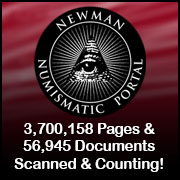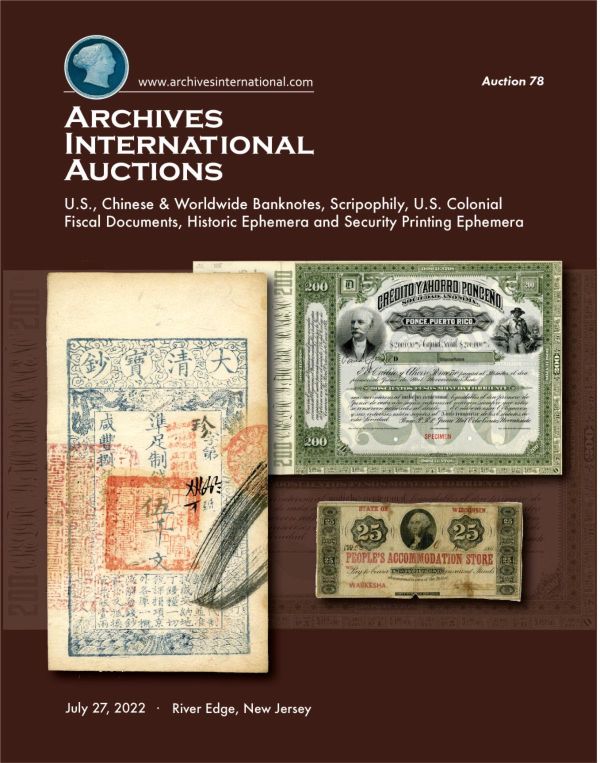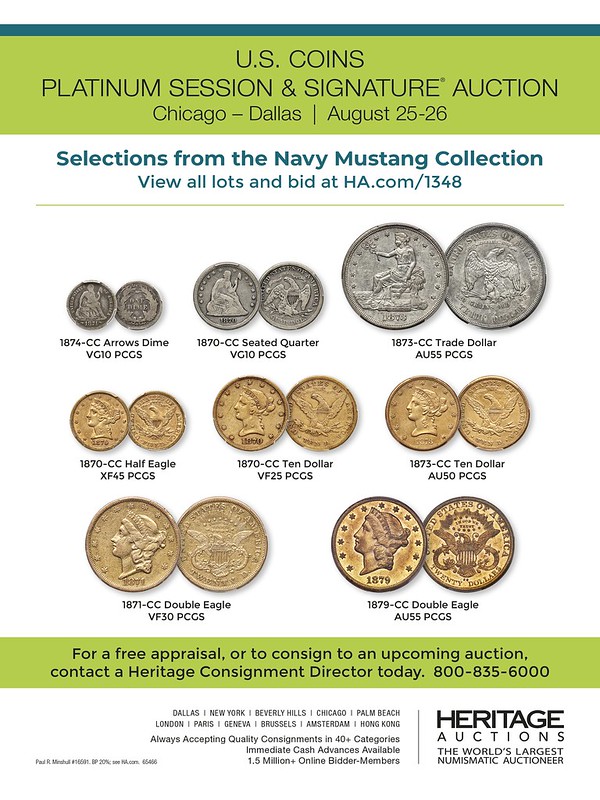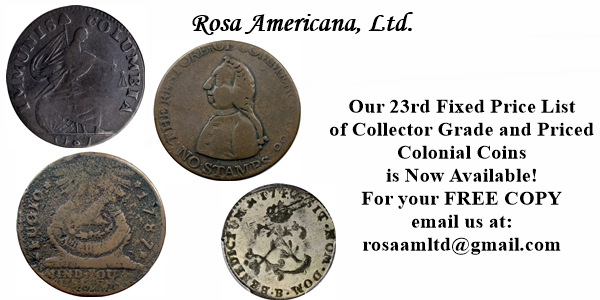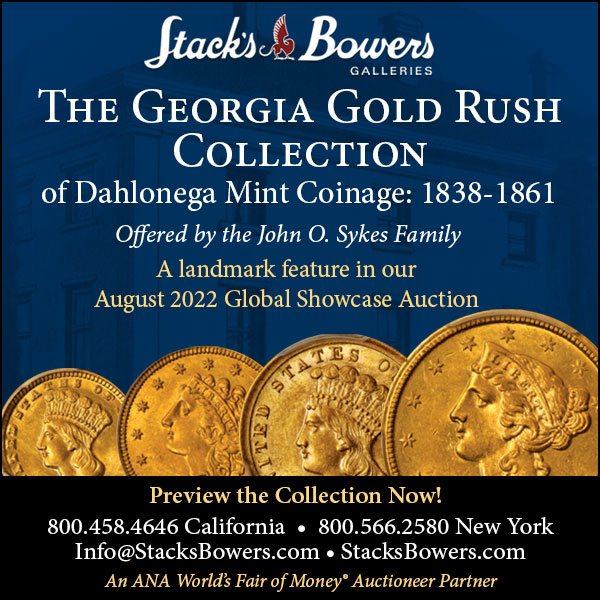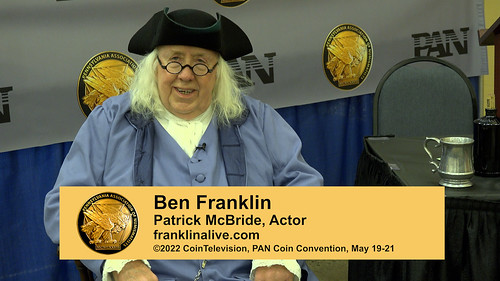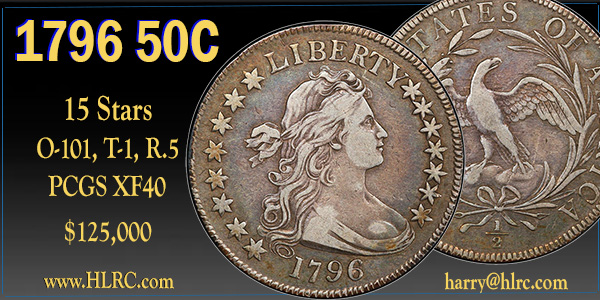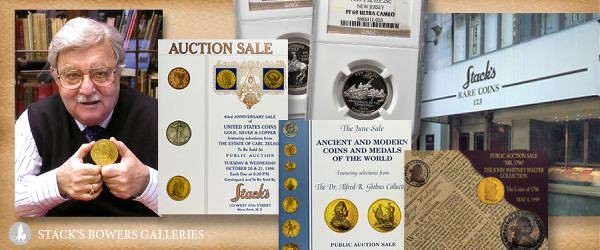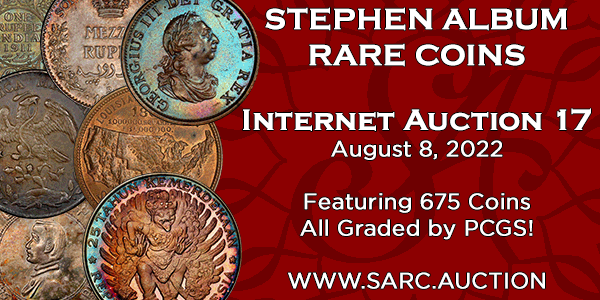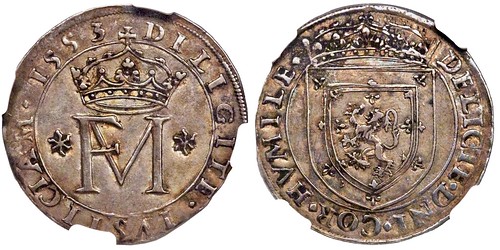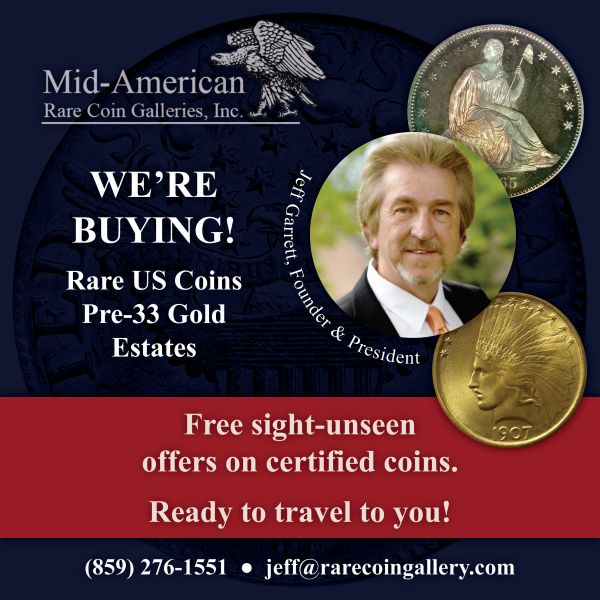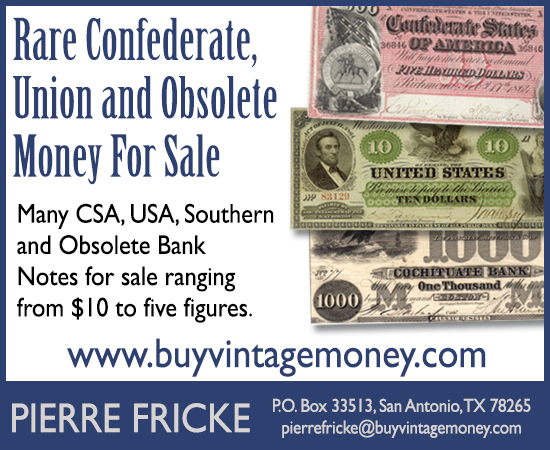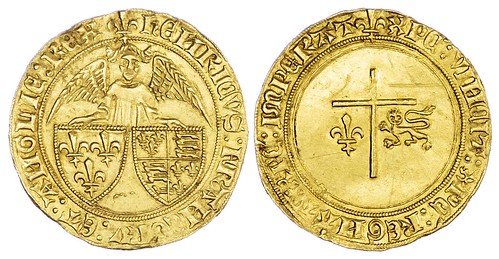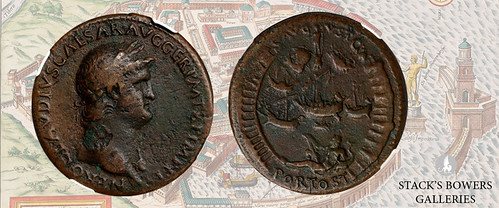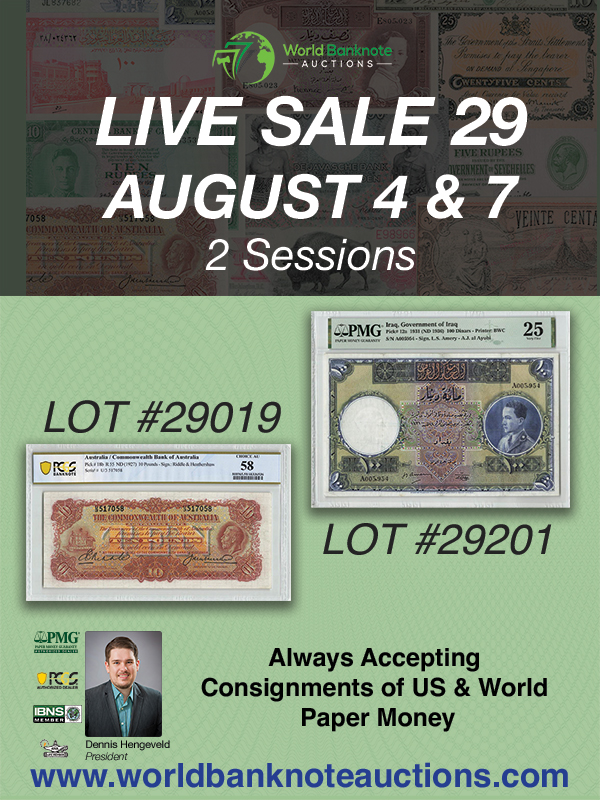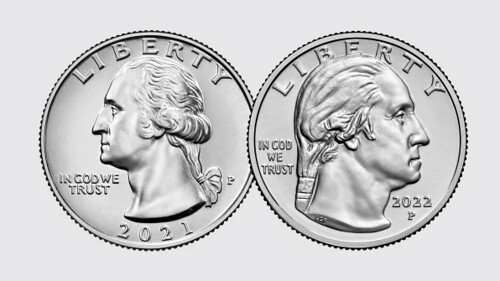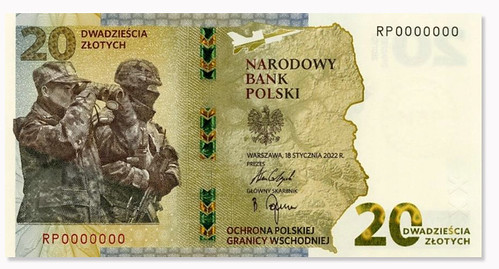
Visit our NBS Sponsors


About UsThe Numismatic Bibliomania Society is a non-profit association devoted to the study and enjoyment of numismatic literature. For more information please see our web site at coinbooks.org SubscriptionsThose wishing to become new E-Sylum subscribers (or wishing to Unsubscribe) can go to the following web page link MembershipThere is a membership application available on the web site Membership Application To join, print the application and return it with your check to the address printed on the application. Print/Digital membership is $40 to addresses in the U.S., and $60 elsewhere. A digital-only membership is available for $25. For those without web access, write to: Charles Heck, Treasurer AsylumFor Asylum mailing address changes and other membership questions, contact Chuck at this email address: treasurer@coinbooks.org SubmissionsTo submit items for publication in The E-Sylum, write to the Editor at this address: whomren@gmail.com BUY THE BOOK BEFORE THE COINSale Calendar |
- WAYNE'S WORDS: THE E-SYLUM JULY 24, 2022
- KOLBE & FANNING BUY OR BID SALE NUMBER 19
- NEW BOOK: TAKTIKON
- NEW BOOK: ONE LITTLE COIN
- NEW BOOK: A FACTOTUM IN THE BOOK TRADE
- GREYSHEET EXPANDS NUMISMATIC DATABASE
- NNP ADDS U.S. TREASURY PRESS RELEASES
- VIDEO: BENJAMIN FRANKLIN
- NOTES FROM E-SYLUM READERS: JULY 24, 2022
- THE UNDEAD CROOKED COIN DEALER
- VOCABULARY TERM: LACQUERED, LACQUERING
- JOSH TATUM REVISITED
- HARVEY STACK'S NUMISMATIC FAMILY, PART 126
- LOUIS VAN BELKUM
- FRED WEINBERG INTERVIEW, PART THREE
- NUMISMAGRAM MEDAL SELECTIONS: JULY 2022
- SOTHEBY'S OFFERS BUZZ ALDRIN MEDALS
- ARCHIVES INTERNATIONAL AUCTION 78
- STACK'S BOWERS TO OFFER VOLCKER COLLECTION
- NUMISMATIC NUGGETS: JULY 24, 2022
- WAYNE'S NUMISMATIC DIARY: JULY 24, 2022
- NERO'S PORT OF OSTIA SESTERTIUS
- SNAKES ON ANCIENT COINS
- THE HISTORY OF UKRAINE'S MONEY
- UKRAINE'S FIRST COMMEMORATIVES SINCE INVASION
- FRASER'S FLIP AND MODERN LOGO DESIGN
- FOR EDEL DAAD: THE NOVEL DEEDS MEDAL
- LOOSE CHANGE: JULY 24, 2022
Click here to read the thin version on the web
Click here to subscribe
Click here to access the complete archive
To comment or submit articles, reply to whomren@gmail.com
Content presented in The E-Sylum is not necessarily researched or independently fact-checked, and views expressed do not necessarily represent those of the Numismatic Bibliomania Society.
WAYNE'S WORDS: THE E-SYLUM JULY 24, 2022
Thank you for reading The E-Sylum. If you enjoy it, please send me the email addresses of friends you think may enjoy it as well and I'll send them a subscription. Contact me at whomren@gmail.com anytime regarding your subscription, or questions, comments or suggestions about our content.
This week we open with a numismatic literature sale, three new books, updates from the Greysheet and Newman Numismatic Portal, and more.
Other topics this week include U.S. Treasury press releases, lacquering, Josh Tatum and the Racketeer nickel, Louis Van Belkum, Buzz Aldrin, auction previews, snakes on ancient coins (with beards!), Ukraine's money, and the Novel Deeds medal.
To learn more about Bucknill's Coins of the Dutch East Indies, Otis Kaye's Heart of the Matter, the first clad coins, the Undead Crooked Coin Dealer, National Bank Notes, the Tsiolkovsky medal, the Benjamin F. Fairless medal, and the Victor Buono method of viewing coins, read on. Have a great week, everyone!
Wayne Homren
Editor, The E-Sylum
KOLBE & FANNING BUY OR BID SALE NUMBER 19
Numismatic Booksellers Kolbe & Fanning submitted this announcement of their nineteenth "Buy or Bid Sale" which closes on August 1, 2022. Good luck, everyone! -Editor
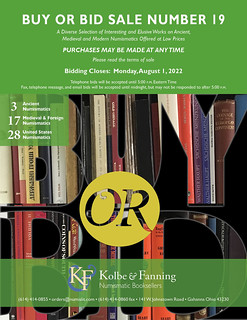 Kolbe & Fanning Numismatic Booksellers have announced our latest
Kolbe & Fanning Numismatic Booksellers have announced our latest Buy or Bid Sale,
which begins now and will close on Monday, August 1, 2022. With hundreds of new additions, the sale focuses on modestly priced books, giving collectors an opportunity to add to their libraries at minimal cost.
The sale includes over 1300 works on ancient, medieval and modern coins, as well as general works, periodicals and sale catalogues. Buy
prices have been kept low to promote sales. To further encourage participation, the firm is offering free domestic shipping to bidders spending at least $300; there is also no packing and processing fee for this sale. Again, please read the Terms of Sale before participating.
As the name of the sale suggests, customers may bid on items they wish to acquire or buy them outright at the published price. The Terms of Sale will give full instructions on how to participate: please read it carefully.
NEW BOOK: TAKTIKON
Bruce Perdue forwarded this announcement of a new book on Byzantine coinage. Thanks. -Editor
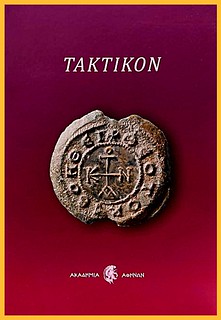 TAKTIKON - Studies on the Prosopography and Administration of the Byzantine Themata
TAKTIKON - Studies on the Prosopography and Administration of the Byzantine Themata
by Olga Karagiorgou, et al (eds.).
Academy of Athens, 2021.
Hard cover, 29 cm. 904 pp., ill.: 638 coloured photos, 241 B&W photos, 6 coloured maps.
Part I: aims and the methodological principles.
Part II: The thematic administration on the evidence of sigillographic and other sources: some case studies.
NEW BOOK: ONE LITTLE COIN
A Canadian Coin News article by Jesse Robitaille discusses a new children's book from the Royal Canadian Numismatic Association. We're republishing it here with permission. Thanks. -Editor
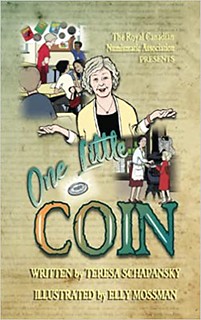 A new children's book published by the Royal Canadian Numismatic Association (RCNA) hit No. 1 on Amazon within a week of its release this June.
A new children's book published by the Royal Canadian Numismatic Association (RCNA) hit No. 1 on Amazon within a week of its release this June.
Written by best-selling author Teresa Schapansky and edited by RCNA national youth co-ordinator Cassidy Stroud, One Little Coin hit the digital shelves in both English and French on June 22. A few days later, Schapansky's 21st book reached the top spot on the Amazon Hot New Releases list for coins and medals. The book's in-person launch will take place at the RCNA Convention on July 22, the show's second of five days, when RCNA officials will offer copies autographed by Schapansky and illustrator Elly Mossman, both of Duncan, B.C.
NEW BOOK: A FACTOTUM IN THE BOOK TRADE
For the bibliophiles among us, here's a new book about the book trade itself. -Editor
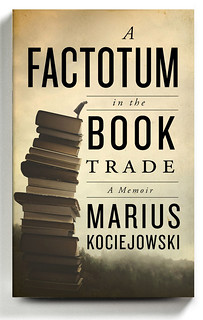 A FACTOTUM IN THE BOOK TRADE
A FACTOTUM IN THE BOOK TRADE
A Memoir
By Marius Kociejowski
349 pages. Biblioasis. $18.95.
I love the smell of old books. More than once, I've said those seven words aloud after entering a used and/or rare bookstore. It's a mistake I won't make again.
In his dyspeptic new memoir, A Factotum in the Book Trade,
Marius Kociejowski, who has worked in some of London's best antiquarian bookstores, turns me into a kebab when he writes:
GREYSHEET EXPANDS NUMISMATIC DATABASE
John Feigenbaum, the President, CEO and managing partner at CDN Publishing published an article this week on the expansion of the firm's numismatic database. -Editor
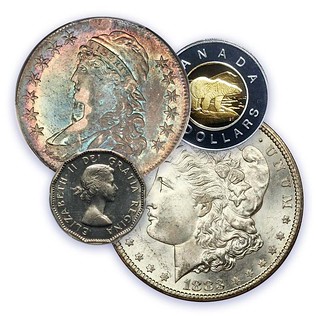 We have been extremely busy here lately working to expand the catalog of coins. Expanding the catalog is the first step to adding pricing, so it's a critical phase in the process. Over the past two months or so, we have added a number of exciting items, including some pricing. If you have an expertise and/or interest in helping build out the catalog, or supplying wholesale price information, please contact us at
editor@greysheet.com.
We have been extremely busy here lately working to expand the catalog of coins. Expanding the catalog is the first step to adding pricing, so it's a critical phase in the process. Over the past two months or so, we have added a number of exciting items, including some pricing. If you have an expertise and/or interest in helping build out the catalog, or supplying wholesale price information, please contact us at
editor@greysheet.com.
New Catalog Entries
1. Early Half Dollars (Overton): We've added 775 listings by Overton variety. With the help from our friends at the Bust Half Nut Club (link) we've also updated to the latest rarity-rating standards. Pricing has also been added for most items, especially those R1-R5.
NNP ADDS U.S. TREASURY PRESS RELEASES
The latest addition to the Newman Numismatic Portal is a long run of U.S. Treasury press releases relating to numismatics. NNP Summer Intern Kellen Hoard provided the following report. -Editor
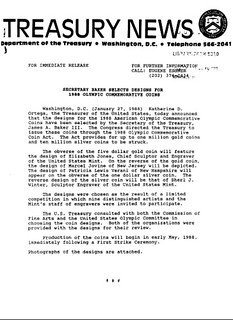 As my first year of college—and my first year of studying international relations—quickly
approaches, I have become acutely aware of how my work this summer with the Newman
Numismatic Portal intersects with my field of interest. Time and again, I find myself
encountering examples of international diplomacy in practice, directly and indirectly, through the
numismatic archival material I am encountering.
As my first year of college—and my first year of studying international relations—quickly
approaches, I have become acutely aware of how my work this summer with the Newman
Numismatic Portal intersects with my field of interest. Time and again, I find myself
encountering examples of international diplomacy in practice, directly and indirectly, through the
numismatic archival material I am encountering.
One project which yielded interesting international lessons involved newly discovered 1833 Mint letters from the National Archives, primarily to and from Mint Director Franklin Peale. Similarly, preparing dozens of Daniel Sedwick Treasure auction catalogs for publication on the NNP allowed mind-bending insights into historical international economic and political systems via the pieces listed within.
But one project, in particular, proved surprisingly relevant and instructional in my numismatic education on international relations: scouring and processing U.S. Treasury press releases from 1970-present. Earlier this summer, I began the process of tracking down every Treasury press release published in the last 52 years which related to numismatics. It was a task which required great patience—a trait my mother has repeatedly declined to ascribe to me—but which I found ultimately rewarding because of its lessons in my area of curiosity.
VIDEO: BENJAMIN FRANKLIN
These are selections from the David Lisot Video Library that feature news and personalities from the world of coin collecting. David has been attending coin conventions since 1972 and began videotaping in 1985. The Newman Numismatic Portal now lists all David's videos on their website at:
https://nnp.wustl.edu/library/multimediadetail/522852
Here's one on Ben Franklin, as portrayed by Pat McBride. -Editor
Ben Franklin, Numismatist.
VIDEO: 37:19.
Patrick McBride, Actor,
franklinalive.com,
David Lisot, Video Producer, CoinTelevision.com,
May 20, 2022.
Most people familiar with history think of Benjamin Franklin as a printer in his early life. He became an international statesman and diplomat later and played a crucial role in American independence. Patrick McBride plays the role of Franklin at the Pennsylvania Association of Numismatists Convention and tells the fantastic story of his life with emphasis on his role in numismatics.
David adds:
"Patrick McBride has become an icon of numismatic spirit for his decisive and startling rendering of Benjamin Franklin. His character brings a sincerity to the role reminiscent of Dennis Boggs' portrayal of Abraham Lincoln. If you want to learn the story of Ben and feel like you are actually in his presence you will enjoy this video."
An excerpt of the video is available for viewing on the Coin Television YouTube Channel at:
https://youtu.be/lR7zpfbKrTk
NOTES FROM E-SYLUM READERS: JULY 24, 2022
On Bucknill's Coins of the Dutch East Indies
Bob Van Arsdell writes:
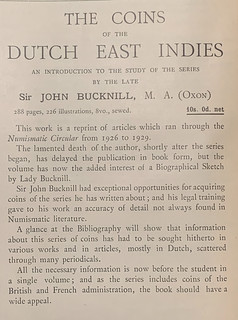 "I saw John Madlon's article about Bucknill's Coins of the Dutch East Indies and thought it looked like an offprint. The book turns out to be a compilation of articles that ran in the Numismatic Circular in the late twenties. I've attached a photo of the announcement for the offprint in the Aug/Sep 1931 Circular.
"I saw John Madlon's article about Bucknill's Coins of the Dutch East Indies and thought it looked like an offprint. The book turns out to be a compilation of articles that ran in the Numismatic Circular in the late twenties. I've attached a photo of the announcement for the offprint in the Aug/Sep 1931 Circular.
"People who need a copy of the book have another source for the content."
Thanks. -Editor
To read the earlier E-Sylum article, see:
NOTES FROM E-SYLUM READERS: JULY 17, 2022 : More on M. H. Rubenstein
(https://www.coinbooks.org/v25/esylum_v25n29a09.html)
Other topics this week include MARGOOD Coin Boards, the ANS Donald Partrick Building medal, and the Victor Buono method of viewing coins. -Editor
THE UNDEAD CROOKED COIN DEALER
An E-Sylum reader shared this cautionary tale noting, "Thank you for your piece this week entitled, The Undead Numismatist.
My letter can be entitled, The Undead Crooked Coin Dealer,
and should be read by every collector."
-Editor
 The American Numismatic Association (ANA) knows my story from 2014, when I asked it to
intercede with the dealer on my behalf, after he sold me two raw coins which he claimed were genuine:
a very nice 1937-D Three-Legged Buffalo Nickel, in AU-55 condition; and a 1916-D Mercury Dime in AU-50 condition. The two coins lay alone under glass under his front counter, and I later realized that the
nickel, which was later graded by Professional Coin Grading Service as AU-55, was used as bait for the
dime, which a major dealer in New York City days later told me looked counterfeit upon close
examination. I remain docked for a sum in the mid-to-high four figures, six years after getting an
uncontested award from my area's Small Claims Court in Westchester County, New York, just north of
New York City. (A local lawyer had advised me to go myself to that court, not to pay expensively for
legal advice at this level of loss.)
The American Numismatic Association (ANA) knows my story from 2014, when I asked it to
intercede with the dealer on my behalf, after he sold me two raw coins which he claimed were genuine:
a very nice 1937-D Three-Legged Buffalo Nickel, in AU-55 condition; and a 1916-D Mercury Dime in AU-50 condition. The two coins lay alone under glass under his front counter, and I later realized that the
nickel, which was later graded by Professional Coin Grading Service as AU-55, was used as bait for the
dime, which a major dealer in New York City days later told me looked counterfeit upon close
examination. I remain docked for a sum in the mid-to-high four figures, six years after getting an
uncontested award from my area's Small Claims Court in Westchester County, New York, just north of
New York City. (A local lawyer had advised me to go myself to that court, not to pay expensively for
legal advice at this level of loss.)
VOCABULARY TERM: LACQUERED, LACQUERING
Here's another entry from Dick Johnson's Encyclopedia of Coin and Medal Terminology. -Editor
Lacquered, Lacquering. Lacquered, Lacquering. The applying – by spraying, dipping or brushing – of a fine coat of lacquer to metallic surfaces. Spraying is the best method for uniform thickness; dipping results in a thicker coat, the excess must be drained; brushing is sometimes difficult to eliminate brush strokes. See lacquer.
JOSH TATUM REVISITED
American Numismatic Biographies author Pete Smith submitted this article on Josh Tatum and the Racketeer Nickel. Thanks! -Editor
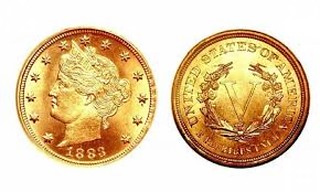 In the May 7, 2000, issue of The E-Sylum, I wrote,
In the May 7, 2000, issue of The E-Sylum, I wrote, I think it would be an interesting exercise for E-Sylum readers to try to come up with the first published reference to Tatum.
I am still looking for that first reference.
When a new United States nickel coin was issued in 1883, there was no shortage of reporting in the papers. I have selected a few stories out of hundreds that were printed in 1883.
HARVEY STACK'S NUMISMATIC FAMILY, PART 126
Stack's Bowers has a backlog of the late Harvey Stack's numismatic memoir articles and will continue publishing them. In this one Harvey moves to the year 1999. -Editor
As we entered the last year of the nineteen hundreds, Stack's was still thriving at its landmark address on West 57th Street near Fifth Avenue and Central Park. Our retail shop, with sit down counters and wonderful displays still had its club house
atmosphere that attracted both the public and seasoned collectors to visit, buy coins, and gather information. It didn't seem to matter what the address was, Stack's Rare Coins managed to keep its welcoming environment, even as the business expanded both as a retail presence and on the auction scene.
LOUIS VAN BELKUM
While researching a book recently, I reached out to Peter Huntoon, who pointed me to a chapter he wrote about pioneer National Bank Note researcher Louis Van Belkum in the new Encyclopedia of U. S. National Bank Notes published jointly by the National Currency Foundation and Society of Paper Money Collectors. With permission, we're republishing it here. Thanks! -Editor
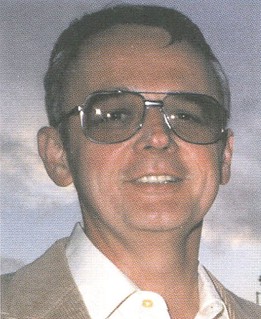 The birth of the modern era of national bank note
collecting can be definitively fixed at 1968 when Louis
Van Belkum's landmark
The birth of the modern era of national bank note
collecting can be definitively fixed at 1968 when Louis
Van Belkum's landmark National Banks of the Note
Issuing Period, 1863-1935
was published.
This book, which summarized a thumbnail history of every note-issuing national bank, also listed the final circulations for the banks. Lou abstracted the information from endless tables found in the 68 annual reports of the Comptroller of the Currency spanning 1863 through 1935.
It became an instant buyer's guide for those of us chasing nationals, and was so successful it was reprinted in 1973. For the first time, we had some idea of what was out there and how much it totaled.
FRED WEINBERG INTERVIEW, PART THREE
Published in Errorscope earlier this year, Greg Bennick's interview with dealer and longtime E-Sylum supporter Fred Weinberg is a wonderful look at the hobby and business of error coin collecting over the last half century. With permission from the Combined Organization of Numismatic Error Collectors of America (CONECA), we're republishing it here. Here's part three of four, where Fred discusses some of his favorite major error coins. -Editor
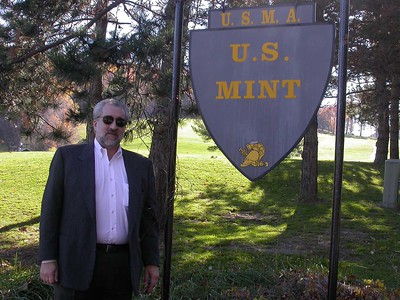 Greg Bennick: Along those lines, what are some specific major errors that you know of that are out there but
haven't seen the light of day in decades? As you said there weren't a lot of error collectors in the 1930's and 1940s so I wonder about years gone by. My dad even once told me that he thought errors were illegal to
collect early on.
Greg Bennick: Along those lines, what are some specific major errors that you know of that are out there but
haven't seen the light of day in decades? As you said there weren't a lot of error collectors in the 1930's and 1940s so I wonder about years gone by. My dad even once told me that he thought errors were illegal to
collect early on.
Fred Weinberg: There were articles that said the Secret Service would confiscate them, and once or twice the Secret Service did, but it turned out that it was mostly false alarms. The Secret Service rarely did that. So I never worried about it.
As far as specific coins, I mean I can think of two that pop off the top my head. One which has to do with the Bolt Collection, and then another one which is another fascinating coin. Let me tell you about the first one.
So in this Bolt Collection there was there was a Gem 1919 Standing Liberty Quarter broad struck on a type one blank that was the size of almost a half dollar. It was spectacular. There was also a 1895 $5 gold piece, 30% off center at 12 o'clock. Gem BU, semi proof like surfaces. I mean there were half cent, large cent errors, off metal type coins. Just incredible material.
One of my favorite coins was an 1888 Liberty nickel with a brass coil struck into the reverse of the coin. And the coil looked like a coiled snake and it had the design of the reverse of the Liberty nickel. If you lifted it up, there was the indentation of where the coil was. That was a two piece set, it was fascinating. And to this day, no one's ever seen a struck in screw or piece of metal or coil on any type coin. All that stuff didn't start happening until the 1960s.
So there's a fascinating story with this coin, I loved the piece. I advertised it for $600 in Coin World. And somebody from Connecticut bought it out of that Coin World ad. This party had never bought an error coin from me before, never bought an error coin after. That coin never surfaced again. But I never stopped thinking about that coin and the coil.
It was 1974 when I sold it. Fast forward to 2010, and I was at the Boston ANA. I saw Bill Fivaz one
morning as we're walking over to the coin show and he said, Hey that coin you've been looking for, for
decades? It's over at Sam Sloat's table.
I ask, What coin?
He said, The Liberty nickel with the coil.
I
immediately ran over there. The gentleman who bought the coin from me in 1974 in Connecticut had gone into
Sam Sloat's, in Stamford Connecticut and sold him that coin about three weeks before the ANA. They'd
brought it to the coin show. They put it out in their showcase for $3500 -- I had sold it for $600 -- and nobody
had said a word about it for three or four days. The second I saw it, I bought it. So I got it back 35 years later.
That particular coin is now in a two-piece PCGS holder with my pedigree on it, and that will be sold at the Central States Auction of my personal error coins. So that to me is a fascinating piece. It's something that I bought in ‘74, couldn't forget about it, bought it again in 2010, and now it'll be sold in 2022.
Greg Bennick: That's an incredible story. I'm so excited you shared that.
Fred Weinberg: It's a great item. The other coin, I just find it fascinating. I started working Numismatics Ltd in
early ‘72, and worked for Harry Gordon -- I was hired to do rare coins, but he knew I played with errors, and so
he said, Yeah, do whatever you want to do, no problem.
A few months into my working there I got a mimeographed ad, which is how most dealers sent out their
inventory at the time, from a gentleman in Cincinnati named Sol Kaplan. He and Abe Kosoff, Jerry Cohen and
Abner Kreisberg, these were guys from the 1940s and ‘50s who were getting older in the 1960s and had
played with coins. Sol Kaplan was a big time dealer in Cincinnati.
So I was looking at his list of rare coins and silver dollars and everything. I got to the last page of the
mimeograph and at the bottom it said, Patterns and miscellaneous
and there was one item listed. It said 1852 $20 Liberty Gold struck on a large cent planchet, pictured in the Judd book, appendix A
. So I
immediately go to my Appendix A, there's a picture of the coin. It was $1,000. I went to Harry and I said,
Harry, I've got to buy this coin. This is incredibly rare.
He said, Hey, if you buy it and think you can make a
profit on it, great.
I bought the coin for $1000 and I sold it for $2500. A couple of years later I bought it back for five grand. I sold it for $7500 to Mark Lighterman, who's a very famous collector in Florida who has probably the best collection of off metal and wrong planchet US coins. Mark still has that coin. He brought it to the FUN show maybe four years ago now, and I saw it there for the first time since the late ‘70s. I love that coin. To get a wrong planchet off metal US gold coin is extremely rare. And that coin today is probably easily worth a quarter of a million dollars.
Greg Bennick: Unbelievable. Is there any coin that got away? Meaning one that you regret?
Fred Weinberg: Yeah, that one. [laughter] I owned that coin two or three times. I wasn't smart enough to keep it for myself!
Greg Bennick: Are there pieces that you never owned but just loved from afar? Like you know that they exist in the world, but you never had a chance to own them?
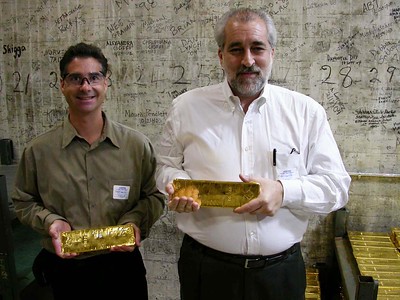 Fred Weinberg: Some of the coins that are in the 100 Greatest Error Coins book that Dave Camire and I
published about 12 years ago, I've never owned those. Some of them I still haven't seen, although I've seen
the photographs. So yes, there's always coins, whether you collect regular coins or any series within regular
coins…nobody's seen everything. There are some spectacular coins out there which I've seen pictures of that I
have not seen physically, that I would love to so that I could just have my eyes glaze over.
Fred Weinberg: Some of the coins that are in the 100 Greatest Error Coins book that Dave Camire and I
published about 12 years ago, I've never owned those. Some of them I still haven't seen, although I've seen
the photographs. So yes, there's always coins, whether you collect regular coins or any series within regular
coins…nobody's seen everything. There are some spectacular coins out there which I've seen pictures of that I
have not seen physically, that I would love to so that I could just have my eyes glaze over.
IMAGE: Dave Camire from NGC and Fred Weinberg. Photo was taken at the West Point Mint in 2009, in the Gold Cage room. -Editor
Greg Bennick: One thing that I appreciate about you and always have, and that I have heard people mention about you as well, is that any time we've ever talked at a show or on the phone, you have a little kid awe and fascination about you, about error coins. You still have that after all this time in the hobby. It's inspiring.
Fred Weinberg: Well thank you. And you know what, that's part of why I say I've never had a boring day in the coin business. I thought I would be doing this all my life. I literally did, up until a few years ago. And now there's a half a dozen reasons why I want to retire. But I've always loved coins, I've never been bored with them. And every day has been something new or something different. It's been a wonderful hobby that I turned into a profession. Not too many people can turn a hobby into a profession for 50 years.
Greg Bennick: It's true. Just in case people are curious, of those half a dozen reasons, are there any public reasons as to why you're retiring at this time, given that your energy and excitement about coins is still so high?
Fred Weinberg: There's no secrets. In no particular order, my reasons are, number one, this is my 50th year, which caused me to reevaluate everything. Number two, I'm going to be 72 in a couple of months. That's a reason to think about retiring. Number three, I've reconnected with my very first girlfriend from 50 years ago, and we're deeply in love. She happens to live in Asheville, North Carolina. So, between her living there and the virus, it's been hard. We try to see each other like every other month if possible. And, a lot of my decision was, my mother passed away at 96 about three years ago, and going through her house and all of her stuff made me realize -- this is maybe reason 6.5 -- as an error dealer, not just a coin dealer, but as an error dealer, I have so many strange things here in my office that if I passed away, there would be an incredible burden and stress on my daughter, and Kathy, my assistant, who's been with me for 37 or 38 years, to get rid of this stuff. They wouldn't know what to do. So between 50 year anniversary, turning 72, reconnecting with my first girlfriend, and also even a year ago, starting to think, you know what, do I really want to continue traveling to coin shows, where I'm going to a convention center in Florida, Chicago, Texas, whatever it is, where I don't know who's vaccinated? I don't know who's wearing a mask? In my seventies and eighties, do I want to expose myself to that, to sell another double struck penny?
It was a confluence of all of those things, plus the cherry on the pie being that in selling all this stuff, the coin market obviously is surprisingly strong right now. I don't think people would have thought it would have been as crazy as it's been for all of 2021 and even for 2022. So this hot market, because of all the money floating around in the economy, whether it's artwork or NFTs or rare coins or trophy coins, the coin market on almost every level is very very strong. This market will soften, whether it's two years from now or four years from now, and then it's going to take a couple of years of a dull flat market, and then it's going to take another couple of years for the market to start to work its way up, though in another couple of years the market will be hot again. I thought about it and I said, why not take advantage of an existing market that I know is good, rather than say, well, I'll wait for the next good market that may or may not appear until 8 to 10 years from now?
So, all of those reasons, Greg, are why I decided to retire and to basically sell most of my collectibles. In addition to all of my coins that Heritage has, they also have a collection of over 200 psychedelic rock posters from San Francisco, Avalon, and Fillmore that I started collecting in the early 1980s that to some degree, I'm more excited to see what they bring. Because I know what the coins will bring within a general range. But some of these posters have not been on the market in decades, and some of them are really good condition, and that's going to be sold in April, along with my coins, at the Central States show. I'm looking forward to seeing what these posters bring.
Greg Bennick: That's really exciting! Just out of curiosity, I never even thought to ask you, what other things do you collect and are you interested in?
Fred Weinberg: You mean as far as non-numismatic or non-coin things? I would say that the posters to a
degree. And if I had to think of what else, I just like collecting ephemera. Heritage also has a lot of stuff that I
had a lot of fun buying. Whether it's US Mint canvas bags, or very early US Mint reports, or letters from the
Treasury or letters from the US Mint talking about coins or different things. I had a book from the Philadelphia
mint that listed how much pay every person got in the 1870s and 1880s, including George Morgan. I liked
collecting what I call mint
memorabilia, things related to the US Mint that weren't necessarily the coins, but
they were the paperwork, or the canvas bags, or just unusual things like that. So that always kind of interested
me. And the posters. I love the posters all the time.
Greg Bennick: That's great. In terms of ephemera, my living room is literally piled with paper and ephemera from your collection that I've purchased recently. I bought a full run of Errorscope, a full run of The Penny, a full run of the Mint Error Collectors Bulletin, along with a couple hundred issues of Errorgram and Error Variety News. I'm going to spend the next few years reading through all that. The history of the hobby is fascinating.
Fred Weinberg: You'll probably run across two dealers named Phil Steiner and Mike Zimpfer. They did a book called Modern Mint Mistakes, which is kind of like Error Trends, telling how US coins are made, and showing coins. They were also very, very big dealers. And they made a major impact on the industry from the late ‘60s to the early to late ‘70s and then they kind of just disappeared. I know one of them was a schoolteacher, but I really don't know what happened to either one of them.
But Steiner and Zimpfer, came out with a good book on coins with a lot of pictures which everybody liked at the time.
Greg Bennick: I do know it. That book was immensely influential on me.
Fred Weinberg: I tell people, part of what's made the error hobby so big nowadays, is that when I started, all you could see was Collectors Clearinghouse, and of course that was just a couple pages in a newspaper with black and white pixelated pictures of an off center or double struck penny or something like that. But with computers and the internet now -- and this is what I honestly believe this really helped stimulate the error hobby in the last 20 years - you go to a Heritage or Stack's website and you look up a coin, and of course the images are huge, and in color, with data about what is being sold. The visual impact is just incredible.
So there's good and bad to that. The good news is, whether it's eBay or Heritage or even my website when I had my inventory up, major error coins made an incredible visual impact on computer screens, which really excited people. I got that feedback all the time. That's the good news and that helped expand the error hobby, and made people excited to buy coins. A mimeographed piece of paper with a black and white picture that you couldn't really tell what it looked like, didn't get people excited. Now you can see the spots, and a mark, and you can tell the luster, and you can see everything. So computers have really, really helped errors.
That's all the good news.
The bad news is basically the flip side of that. Because of computers, anybody that finds anything in
their pocket change or roll hunting searches that looks different, either they automatically assume it's an error
and worth a fortune, or, what I've been finding and it's been very frustrating just the last few years, is that they
start their own website. And they'll either take a damaged coin and say it's worth $1,000 or take a genuine
error coin and say it's worth $10,000, and they put it on their website. And I then dealers across the country,
get phone calls and emails that say things like, I have an off center penny. How close to $1000 will you pay
me? Because that's what somebody says it's worth on Etsy.
Or, Here's this coin that's been hit with a
hammer and Etsy says it's worth $10,000... what will you pay me?
And I have to explain to them that these
people put these things out there to get clicks or likes, and that an off center penny is worth $10, and that a
damaged coin is worth nothing.
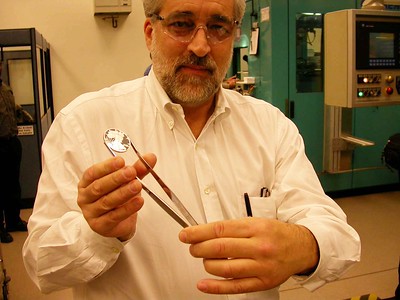 But it's enabled anybody to think, because of the bad information that's out there, that any coin that
they have that looks different, which they just found on Etsy for $5000 or $10,000, is worth that. And then they
get mad at you when you tell them it's damaged. I've seen the good and the bad and the plus and the minus of
the Internet. Overall, obviously it's a plus. And most dealers just ignore phone calls and emails from people
that find such things in their pocket change.
But it's enabled anybody to think, because of the bad information that's out there, that any coin that
they have that looks different, which they just found on Etsy for $5000 or $10,000, is worth that. And then they
get mad at you when you tell them it's damaged. I've seen the good and the bad and the plus and the minus of
the Internet. Overall, obviously it's a plus. And most dealers just ignore phone calls and emails from people
that find such things in their pocket change.
I've always taken the approach that it's my responsibility as an error dealer to let people know what
they have. In the old days, I would answer any email at least three times. In the original reply, Thank
you... based on your photographs your coin was gold plated.
They'd send me another one, asking why would
people do that? And I would reply, Well, people do that for this reason for that reason, out of boredom.
And
then maybe one other follow up question. In the last couple of years, I've had to come up with what I call a
canned reply, which basically says, Hello, thank you for your email.
However, due to all the quantity of emails
that we get every day, we can't reply to all of them individually. Please go to cointalk.com and post your
images there.
I mean I have to defer people, because people think that you have nothing better to do all day in your
business but to spend ten or twenty minutes talking about their coins. And when I keep on saying to them,
Email me a picture and I'm more than happy to try to tell you what it is
and they reply, Well, I don't have that
then I have to say, Well, then I can't help you.
They will reply with Well, but let me describe it to you…
but I
can't tell on the phone from their verbal description what it is. So then they sometimes offer to send the coin to
me. I don't have the time to do that. So the internet has been a little frustrating at times, but overall obviously
it's been a major benefit to the coin business and to errors.
For more information about CONECA, see:
https://conecaonline.org/
To read the earlier articles in this series, see:
Fred Weinberg Interview, Part One
(https://www.coinbooks.org/v25/esylum_v25n28a15.html)
Fred Weinberg Interview, Part Two
(https://www.coinbooks.org/v25/esylum_v25n29a17.html)
NUMISMAGRAM MEDAL SELECTIONS: JULY 2022
Jeremy Bostwick at Numismagram had a couple uploads of fresh medals and related exonumia to his website this month, and passed along some of these highlights. For all of the new items from this month, please visit numismagram.com/inventory. -Editor
102115 | SCOTLAND & FRANCE. François & Mary silver Jeton or Pattern Testoon. Dated 1553 (though the couple wouldn't be married until 1558) (28mm, 3.71 g, 10h). By N. Emery, likely in Paris. DILIGITE IVSTICIAM 1553, crowned FM (for François & Mary) monogram; sunburst to left and right / DELICTE DNI COR HVMILE, crowned coat-of-arms. MI 65/5; Burns vol. II, pp. 344-346 & pl. LXVI (fig. 916); Forrer II, pp. 15-16 (this type mentioned and illustrated); National Museum of Edinburgh 248; Lucien LaRiviere Coll. 285 = Marian Sinton Coll. 1683 = Robert William Cochran-Patrick Coll. 18 = London Coins 126, lot 559; Dundee Coll. –; McDonald Coll. –; Loch Ness Coll. –; NY Sale XXXII, lot 355 (which realized a total of $1,872 in January 2014). NGC EF-45. Lightly toned and fairly well struck for the type. For cert verification, please follow this link: https://www.ngccoin.com/certlookup/3748517-001/45/. An extremely rare and historically important type missing from most advanced Scottish collections. Apart from the specimen here, only two other examples of the type have been observed to have sold over the past two decades, the more recent being the specimen in the 2014 NY Sale. $1,985.
Mary was just six days old when her father, King James V of Scotland, died, leaving her as an infant queen. During her minority, the realm was administered by regents, with King Henri II of France proposing an alliance between France and Scotland through an eventual marriage of Mary to his son and heir, François. Given the enmity at that time with England for both France and Scotland, such an arrangement made sense, and Mary was sent to France for safety and upbringing in 1548. According to French tradition, when Mary was deemed to have come of age, she was able to formally ratify her marriage contract to François. This occurred in December 1553, though the wedding itself would not occur until 1558.
In the meantime, it is likely that this jeton, as well as the similar type (MI 66/6), sometimes referred to in the past as "pattern testoons" on account of their similarities to actual Scottish coinage of the time, was intended for usage within the royal household up until the marriage took place. Sadly for Mary, this marriage would be very short-lived, as François died just two years later. Mary would marry two other times before her forced abdication and then eventual execution under the orders of her first cousin once removed, Queen Elizabeth I of England. Incorrectly attributed on the holder as MI 66/6, as it is actually MI 65/5.
To read the complete item description, see:
102115 | SCOTLAND & FRANCE. François & Mary silver Jeton or Pattern Testoon.
(https://www.numismagram.com/product-page/102115)
SOTHEBY'S OFFERS BUZZ ALDRIN MEDALS
A number of important medals are being offered as part of Sotheby's sale of Apollo 11 Lunar Module Pilot Buzz Aldrin. -Editor
Sotheby's is thrilled to announce Buzz Aldrin: American Icon — the most important Space Exploration collection to come to market. The collection, consigned directly by Apollo 11 Lunar Module Pilot Buzz Aldrin, who has carefully preserved the materials since his missions, includes the most important mission flown artifacts from both the Gemini XII and Apollo 11 missions.
ARCHIVES INTERNATIONAL AUCTION 78
Here is the announcement for the July 27, 2022 sale by Archives International Auctions. -Editor
ARCHIVES INTERNATIONAL AUCTIONS OFFERS HISTORIC U.S., CHINESE & WORLD BANKNOTES, AND SCRIPOPHILY COLLECTION ON JULY 27, 2022
The auction will be held by Archives International Auctions at their offices in River Edge, N.J.
STACK'S BOWERS TO OFFER VOLCKER COLLECTION
This press release describes Stack's Bowers Galleries' upcoming offering of the Paul A. Volcker, Jr. collection. -Editor
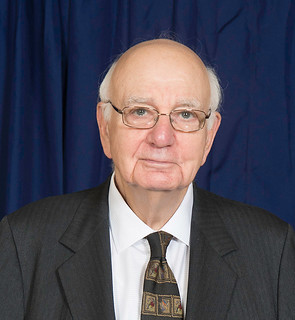 In a career spanning nearly six decades including public service under five U.S. presidents, Paul
A. Volcker, Jr. worked for private and public firms as an esteemed economist and helped shape the nation's
economic policies. In these roles he received numerous awards, medals, and commendations from entities both
domestic and foreign, which Stack's Bowers Galleries is proud to offer at auction to private collectors and museums.
In addition to the awards, Volcker collected a small group of numismatic coins that will also be offered in the
August sale.
In a career spanning nearly six decades including public service under five U.S. presidents, Paul
A. Volcker, Jr. worked for private and public firms as an esteemed economist and helped shape the nation's
economic policies. In these roles he received numerous awards, medals, and commendations from entities both
domestic and foreign, which Stack's Bowers Galleries is proud to offer at auction to private collectors and museums.
In addition to the awards, Volcker collected a small group of numismatic coins that will also be offered in the
August sale.
Beginning in 1952, Volcker joined the staff of the Federal Reserve Bank of New York as a full-time economist. After five years there, he moved on to Chase Manhattan Bank where he served as a financial economist. In 1962 Volcker joined the U.S. Treasury Department as Director of Financial Analysis and, a year later, was appointed Deputy Under Secretary for Monetary Affairs. He returned to Chase Manhattan Bank as Vice President and Director of Planning in 1965.
THE BOOK BAZARRE
NUMISMATIC NUGGETS: JULY 24, 2022
Here's a selection of interesting or unusual items I came across in the marketplace this week. Tell us what you think of some of these. -Editor
Henry VI, King of England and France (1422-53), Angelot d'Or, St. Lô Mint, minted from 24th May 1427, Angel Gabriel with outstretched wings resting hands on the shields of France and England, mintmark fleur de lis both sides, reads HENRICVS FRANCORV ET ANGLIE REX. Rev, Latin cross, lis to left, lion to right, legend surrounds XPC VINCIT XPC REGNAT XPC IMPERAT, 2.32g (S.8165; Elias.277 RR; Schneider 134; AGC 394A dies 2/a).
Offered by Baldwin's. -Editor
To read the complete lot description, see:
HENRY VI ANGELOT D'OR (1422-53)
(https://www.baldwin.co.uk/product/henry-vi-angelot-dor-1422-53/#tab-description)
Other topics this week include the Charentaise medal, and the Nanking Inn counterstamp. -Editor
WAYNE'S NUMISMATIC DIARY: JULY 24, 2022
Mike Packard was the host for the July 19, 2022 dinner of my Northern Virginia Numismatic Social group Nummis Nova. He'd made reservations at The Esposito's in Fairfax, a nice little Italian restaurant we'd visited several times before.
I saw Robert Hoppensteadt in the parking lot. After texting my wife I headed inside where a group of tables in our usual corner was waiting. In addition to myself, Mike and Robert, the night's attendees included members Daryl Haynor, Roger Burdette, Steve Bishop, Dave Schenkman, Eric Schena, Jon Radel, Tom Kays, Julian Leidman and my guest, 16-year-old Jonas Denenberg. Jonas is a member of the Fairfax Coin Club and already a busy coin dealer traveling to shows all across the country.
I hadn't seen Jonas since his latest growth spurt, and he towered over me at six feet plus. We sat together at an end of the table near Mike and Roger. Here's my photo of the group.
NERO'S PORT OF OSTIA SESTERTIUS
In a Stack's Bowers blog article, Jeremy Bostwick discusses the Port of Ostia Sestertius of Nero. -Editor
Given its larger-format size (corresponding to a diameter between that of a standard Half Dollar and Silver Dollar), the Roman Sestertius was always the prime candidate for more artistically ambitious designs. This broad canvas allowed the celator great leverage to pack as much detail as possible onto the flan—an aspect that was essentially impossible upon other denominations given their smaller diameters. As such, it made the Sestertius the perfect vehicle for commemorative events. Given the highly propagandizing nature of some Roman coinage, it presented an opportunity for an emperor to promote various events and locales that would garner even more support from the populace.
SNAKES ON ANCIENT COINS
In his latest CoinWeek article, Mike Markowitz examines snakes on ancient coins - even snakes with beards. Here's an excerpt - be sure to read the complete article online. -Editor
MOVING SILENTLY AND mysteriously without legs, the snake has always held a powerful grip on the human imagination. The snake is a complex and multi-dimensional symbol in Western art. At various times and places, it has represented fertility, rebirth, healing, and guardianship, as well as the forces of darkness and evil. In the CoinArchives Pro database, which records almost two million ancient coin auction sales that took place during the last two decades, a recent search for the term snake
produced 36,918 hits. The synonym serpent
produced 39,759 hits. That's nothing to hiss at.
THE HISTORY OF UKRAINE'S MONEY
National Numismatic Collection Curator Ellen Feingold published an article in Smithsonian Magazine about how medieval money shaped Ukraine's modern identity. Here's an excerpt. -Editor
Before the February 2022 Russian invasion of Ukraine, few outside of the country took note of the trident symbol at the center of Ukraine's national emblem. But in the days following the invasion, the trident was beamed around the world, appearing in the backdrops at press conferences and embossed on the clothing worn by the nation's leaders and soldiers.
The origins of the ubiquitous trident, or tryzub, lie in the medieval period when the city of Kyiv was the seat of power of a state known as Kyivan Rus'. Encompassing all of modern-day Ukraine, Belarus and parts of Russia, this vast territory was ruled by the Rurik dynasty. As the dynasty's symbol, the trident appeared on the first coins minted in Kyiv around the turn of the 11th century. These coins—as well as other types of medieval money—have become a central part of how modern Ukraine tells its national story and displays its national identity.
UKRAINE'S FIRST COMMEMORATIVES SINCE INVASION
A World Mint News blog article by Michael Alexander features the first new commemorative coins released by Ukraine since the Russian invasion. -Editor
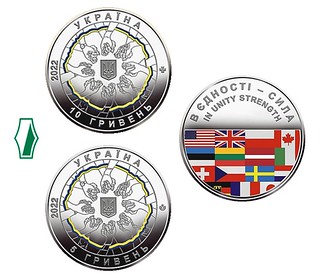 The National Bank of Ukraine has just released its first commemorative coins since the country's invasion by Russian forces on the 24th February. Since this day, the nation and its people have been staunchly defending their homeland and repelling the deadly, destructive aggression brought to their country by the president and government in the Kremlin. In support of Ukraine's defence of their territory, numerous countries have come to their aid with funds, weapons, military advisors, humanitarian assistance, and moral support, especially to Volodymyr Zelenskyy, president of Ukraine since 2019.
The National Bank of Ukraine has just released its first commemorative coins since the country's invasion by Russian forces on the 24th February. Since this day, the nation and its people have been staunchly defending their homeland and repelling the deadly, destructive aggression brought to their country by the president and government in the Kremlin. In support of Ukraine's defence of their territory, numerous countries have come to their aid with funds, weapons, military advisors, humanitarian assistance, and moral support, especially to Volodymyr Zelenskyy, president of Ukraine since 2019.
During a short ceremony at the National Bank, a silver coin was presented to representatives from the embassies of France, Japan, the Netherlands, the United Kingdom, Canada, Germany, Estonia, Latvia, Sweden, the United States, the Czech Republic, and Poland, each country noted on the commemorative coin. The meeting was overseen by Deputy National Bank Governor Oleksiy Shaban and Ukraine's First Deputy Foreign Minister Emine Dzhaparova.
FRASER'S FLIP AND MODERN LOGO DESIGN
The portrait change on the 2022 U.S. quarters parallels a shift in the design of corporate logos, according to this Fast Company article. -Editor
One change to the U.S. quarter this year has gone mostly unnoticed. The portrait of George Washington on the coin, which had faced left since its first appearance in 1932, flipped to face right in 2022. Based on internet chatter, the recent barely-perceptible tweak to Instagram's logo attracted much more attention. But the about-face on the quarter reflects a large trend in American logo design over the past century.
The new portrayal of Washington is a design by American sculptor Laura Gardin Fraser that had been recommended in 1931 to adorn the coin, but was snubbed in favor of John Flanagan's left-facing offering. Somewhat ironically, Fraser's Washington appears more masculine and less fussy than Flanagan's.
FOR EDEL DAAD: THE NOVEL DEEDS MEDAL
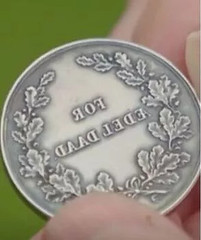
An article published by the Express on July 17th caught my eye this week with an odd illustration of a medal. A search for more information turned up a Februrary 18, 2021 article by The Sun on the same topic with a more sensible illustration. Here's an excerpt from the better Sun article. -Editor
The proud owner of the token of bravery was clearly emotional as he heard what military specialist Mark Smith had to say.
Examining the artefact, which had the words 'for edel daad' written on it, Mark told the guest it was from the "Swedish-Norwegian royal family when they were joined together."
"It's called the noble deeds medal and it was given out for saving life at sea, usually it was for ship wrecks."
Appearing on the BBC show, the owner explained the back story and said: "I found out it was my great great grandfather's who was actually 14 at the time.
THE BOOK BAZARRE
LOOSE CHANGE: JULY 24, 2022
Here are some additional items in the media this week that may be of interest. -Editor
A Coin World article by Arthur L. Friedberg discusses Poland's new 10-zloty note. -Editor
It issued a new commemorative legal tender 20-zloty bank note ($4.22 U.S.) on July 19 with a theme called Protection of Poland's Eastern Border.
It was made available for 130 zlotych each at 16 regional branches of the national bank and at its online store collector.nbp.pl. The issue limit was set at 80,000 pieces.
The note comes in a folder including text that pulls no punches. It denigrates the Russian Federation's attempts at dominance and the Putin regime's actions aimed at trying to rebuild the Soviet post-World War II empire. It also accuses Belarus and its dictator Alexander Lukashenko of using Belarus as a center of migration pressure by intentionally bringing migrants, mainly from Muslim countries and wanting to go to Western Europe, right up to the Polish border.
To read the complete article, see:
Polish 10-zloty note protests Russian acts of aggression
(https://www.coinworld.com/news/paper-money/polish-10-zloty-note-protests-russian-acts-of-aggression)
For more information, or to order, see:
20ZL PROTECTION OF THE POLISH EASTERN BORDER - BANKNOT
(https://www.redisbad.pl/en_US/p/20zl-Protection-of-the-Polish-Eastern-Border-banknot/2350)
Other topics this week include Wounded Knee Medals of Honor. -Editor

